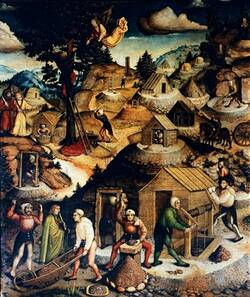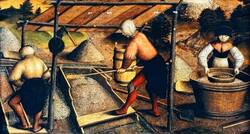Let's start by looking at the panel top centre. You'll notice a complex mining landscape littered with spoil heaps, shafts and tunnels. Some miners are seen entering the tunnels, while others dump debris in front of them. The scene shows pit-men mining silver ore in the early 16th century. On the two smaller side panels and the predella, you can see how they went on to process the ore.
This picture is by a painter called Hans Hesse. In many ways, it mixes Gothic forms with Renaissance influences, so it's very important in terms of art history. But above all, it presents an impressive view of how prominent the role of silver mining was in Saxony in historical times.
The Bergaltar, or Mining Altar, was commissioned by the miners' guild. Thanks to the elaborate woodcarving technique and the paintings (incidentally on the back of the altar), it is still regarded as an exceptional work of art. The images from the miners' working environment seem very realistic and form a single whole in terms of both composition and content. Apparently, the artist is at home in the world of the miners. He displays considerable specialist knowledge, showing the typical production process of the day in detail – from the mining of the ore, via washing and smelting, all the way to minting the silver into coins.
Two images go beyond the miners' specific working environment and explicitly refer to a spiritual, metaphysical connection. Take a look at the left-hand upper quarter of the centre panel. It shows the founding legend of Annaberg. According to the tale, an angel appeared in a dream to Daniel Knappe (whose name means "miner") and told him of a large tree. He dug at the roots of the tree and came across a rich vein of silver. Now look a little lower down, at the person in the bright green robe. He's the only religious figure shown here – Saint Wolfgang, patron saint of miners.
The scenes on the panels reflect the spiritual exaltation of the world of work. It was an early sign of the Age of Reformation, although it took almost another two decades before the movement reached Annaberg.



